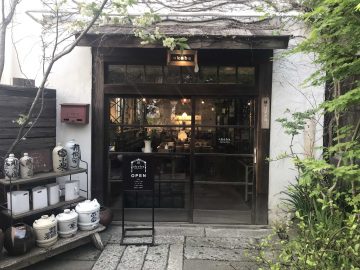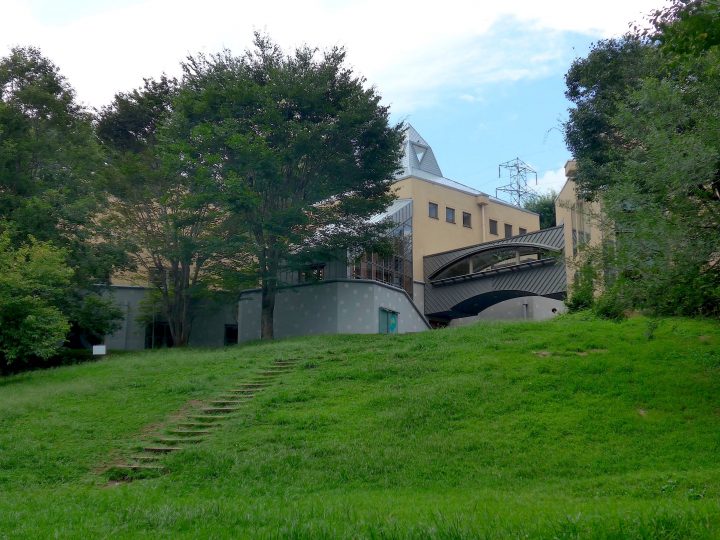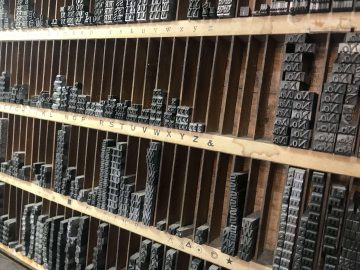Yokohama Museum of Art "Cai Guo-Qiang: Return" Gunpowder Drawing Production Site Report

TEXT: Hiroo Miyakoshi Published on July 2, 2015
Click here to watch a video of the gunpowder drawings being created at the "Cai Guo-Qiang: Return" exhibition
"Cai Guo-Qiang: Return" Gunpowder Drawing Production Site Report
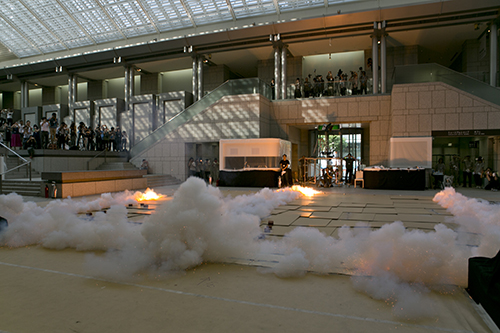
Photo by Wen-You Cai, courtesy Cai Studio
On Saturday, June 20th, contemporary artist Cai Guo-Qiang held a press conference at the Yokohama Museum of Art Grand Gallery to show off his gunpowder drawing. The work produced on this day was the right side of his new gunpowder drawing "Cherry Blossoms at Night," which will be exhibited at the "Cai Guo-Qiang Exhibition: Coming and Going" exhibition at the Yokohama Museum of Art from Saturday, July 11th. The completed work will be 2,400cm long and 800cm high, making it the largest gunpowder painting to date.
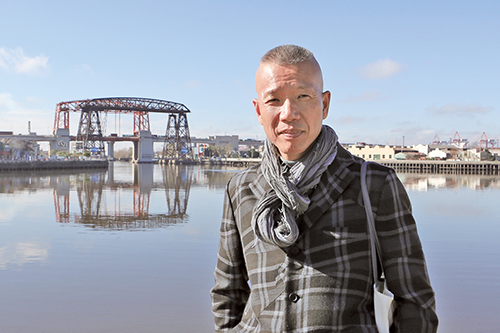
Cai Guo-Qiang Photo by Wen-You Cai, courtesy Cai Studio
The title "Returning Home" comes from the Chinese poet Tao Yuanming's masterpiece "Speech on Returning Home," which sings of the free spirit of a poet who leaves his government job and returns to his hometown, facing reality, returning to his own path, and entrusting himself to nature. Although Cai is now active worldwide, it was during his stay in Japan from 1986 to 1995 that he began to build his career as an artist in earnest. The title "Returning Home" reflects Cai's sense of returning to Japan, as well as his state of mind of returning to his roots as an artist.
When the public production was about to begin, the press gathered in a place overlooking the Grand Gallery (the museum entrance). Cardboard-covered paper was laid out on the first floor of the Grand Gallery, and volunteer staff were waiting around it. Tsai has been working with volunteer staff since the beginning of her activities, and several dozen volunteer staff participated in the production of this new work.
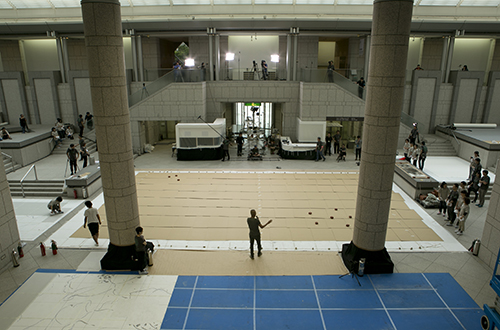
Photo by Wen-You Cai, courtesy Cai Studio
Gunpowder drawing is a painting technique in which gunpowder is exploded to fix an image onto a canvas or washi paper. Several sheets of thick paper or glassine paper (thin paper) are layered underneath the cardboard, and among them is a stencil with the outline of the picture cut out. When the gunpowder explodes, the cut-out areas are burned and colored.
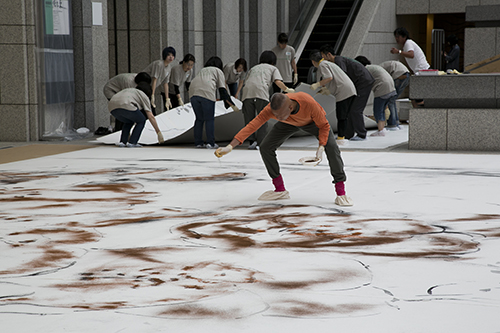
The sketch creation process. Photo by Wen-You Cai, courtesy Cai Studio
Before the ignition, Tsai gave a presentation in Japanese about gunpowder drawing.
"There is a special tension in creating a work in front of other people. Using gunpowder involves chance, which brings about new possibilities. The reaction of gunpowder is different every time, so it's both exciting and nerve-wracking. It's this uncontrollable aspect that is the appeal. Also, gunpowder drawings cannot be created by one person, but are realized through collaboration with local people. I have collaborated in various countries so far, and the working style of volunteers varies from country to country. The volunteers in Japan are wonderful. This made me very happy."
Finally, Tsai said, "I will do my best today. The rest will be up to God," and lit the fuse.
About two or three seconds after the small sound of the fuse burning was heard, a loud explosion was heard and smoke rose, and the area was engulfed in white smoke.
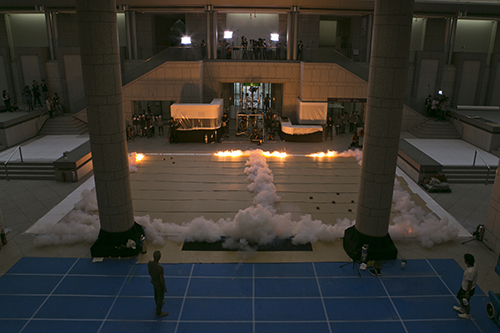
Photo by Wen-You Cai, courtesy Cai Studio
As the smoke cleared, volunteer staff gathered around the fuse and began putting out the smoldering fuse. They then removed the cardboard and peeled off the layers of paper, one by one. With each peel, a new layer was revealed, and the outline gradually became clearer, revealing a large cherry blossom.
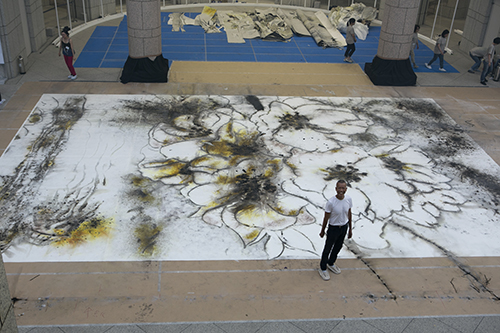
Photo by Wen-You Cai, courtesy Cai Studio
After the paper had been peeled off, an interview was held with Tsai in front of the painting, which still had soot remaining.
Interview with Cai Guo-Qiang
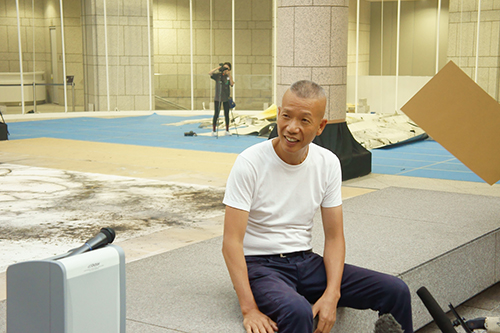
Photo by Yu Miyakoshi
- Why did you choose "cherry blossoms" as your theme this time?
When I was thinking about what to paint after having an exhibition in Japan for the first time in a long time, I first studied the paintings of my Japanese predecessors, such as Yokoyama Taikan. Yokoyama Taikan also painted cherry blossoms. So the challenge of whether I could paint cherry blossoms using gunpowder became a motivation for me. Compared to the beautiful and soft cherry blossoms, gunpowder is violent and energetic. There is a big difference there. Another thing is that I thought that the fleeting life of cherry blossoms might have something in common with the fleeting fate of gunpowder. I thought that connection was interesting. It is difficult to paint something gentle like a flower with gunpowder, but as I have gotten older, I have come to want to express something a little more familiar, warm, or soft, rather than something on a large scale. That is the meaning behind the drawing this time.
-Why did you choose the title "Return and Return"?
When I started living in Japan and started working as an artist in earnest, it was a very important time for me as an artist. Since then, I have created works in various countries around the world, but recently I thought I would like to go back to my roots when I was young. I thought it would be good to go back to Japan and think about what was there when I was young and what I have lost now. That's why I thought the title "Return and Return" was good. The theme of flowers and nature is also a feeling of returning to the earth.

"Brazilian Flowers and Birds" (detail), 2013, gunpowder and washi paper, artist's collection (reference image)
Commissioned by Banco do Brazil.Photo by Zhang Feiyu, courtesy Cai Studio
- Why are you so committed to using gunpowder as a technique?
The appeal is the sense of anxiety and excitement that can never be controlled. Even if it goes well today, you never know what will happen next time. Gunpowder has infinite possibilities. You can draw flowers, the universe, anything. Also, gunpowder cannot be transported by plane, so I use gunpowder from the country I visit and collaborate with volunteers from that country. From there, new difficulties and new fun emerge every time. In January of this year, I did a gunpowder drawing in Argentina, but the gunpowder was slow and the drawing was over-burned. I was really disappointed at that time. So I backed it with paper and exhibited it, but when I actually exhibited it, the rawness and strength of the South American land was revealed there. Artists are like "seeds." Wherever I go, I look forward to burying myself in the land and seeing something new emerge from the dialogue with the land.
- What prompted you to start using gunpowder?
I am a serious and rational person. That's fine as a person, but as an artist, I find it a little easy to control and not very interesting. My father also paints, but he is too serious, and I thought I might become like that too (laughs). So I've always been looking for ways to incorporate chance and unexpectedness into my work. I've tried a lot of things, like using fire and electric fans. So I think one of the reasons I use gunpowder is the destruction of this humanity of mine. Another reason is that firecrackers were easy to get in my hometown. And when I was young, there were a lot of wars between my hometown and Taiwan. So when I thought about what I could challenge myself to do as a contemporary artist, I came up with the idea of using gunpowder.
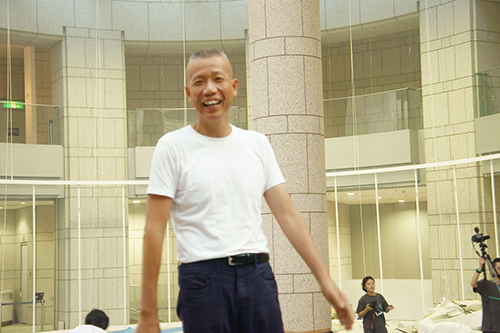
Photo by Yu Miyakoshi
This interview conveyed Tsai's sincere thoughts.
“Cai Guo-Qiang Exhibition: Return and Return”
The work "Night Cherry Blossoms" created on this day will be exhibited in the Grand Gallery. Cherry blossoms also remind Tsai of the "Iwaki 10,000 Cherry Blossoms Project" in Fukushima, which he has a deep connection with.
The Iwaki Ten Thousand Cherry Trees Project was started with the aim of passing on the memory of the Great East Japan Earthquake and leaving the world's best cherry blossom viewing spot to future generations. Planting cherry trees began in 2011 in Iwaki's Satoyama, with the ultimate goal of planting 99,000 trees. Tsai supports this project, and in 2014, to commemorate the 20th anniversary of exchanges with Iwaki City, he exhibited a work called "Circling the Light of a Dragon Bone" at the top of Tateyama, where the "Iwaki Corridor Museum" is located, which was created in collaboration with the project. "Circling the Light of a Dragon Bone" was the first piece that Tsai and the "Iwaki Team," consisting of Iwaki citizens, worked on together in 1994. The friendship between the "Iwaki Team" and Tsai deepened through this production, and they remain friends to this day. According to "Iwaki Manbonzakura News" (Issue 16, 2014, published by the Iwaki Manbonzakura Project Executive Committee), the "Kaikoichi Ryukotsu" exhibit in Tateyama was described as "a corridor staircase that rises one step at a time toward the sky. When you reach the end, the view suddenly opens up before you, and you see the approximately 13-meter-long keel, which has been standing for 20 years, lying there alongside cherry blossoms in full bloom."
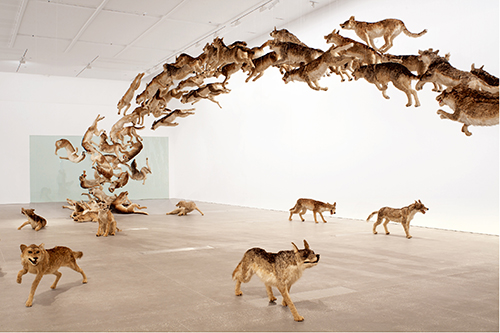
"Wall Hitting" 2006, 99 wolf replicas, glass, variable size, commissioned by Deutsche Bank
The Deutsche Bank Collection Photo by Jon Linkins, courtesy: Queensland Art Gallery | Gallery of Modern Art
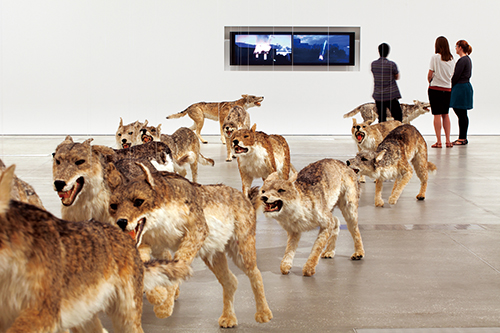
"Wall Hitting" 2006, 99 wolf replicas, glass, variable size, commissioned by Deutsche Bank
The Deutsche Bank Collection Photo by Jon Linkins, courtesy: Queensland Art Gallery | Gallery of Modern Art
Cai Guo-Qiang's exhibition "Cai Guo-Qiang: Return" will open on Saturday, July 11th, and will be his first solo exhibition in Japan in seven years. In addition to his new work "Cherry Blossoms at Night," which was created in public, the exhibition will feature "Striking the Wall" (2006), which depicts a pack of 99 replica wolves flying through the sky, a new terracotta installation, and a porcelain work made from gunpowder, "Spring, Summer, Autumn, Winter" (2014). I'm looking forward to seeing these dynamic works, and when I saw "Cherry Blossoms at Night" again, I wanted to listen carefully to the artist's contemplation and the silence that unfolds beyond the ruins.

